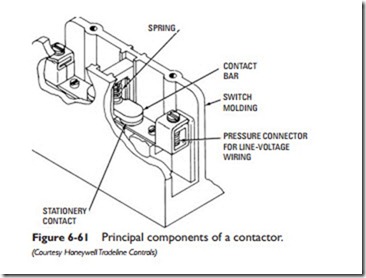Cleaning Contactors
Sometimes a contactor will fail to operate because a layer of dust and lint has accumulated on the electrical contacts. This dust and lint can be removed by placing a file card between the contacts, closing the contacts against the card, and sliding the card back and forth. This will usually clean the contacts. Do not use abrasive material to clean the contacts because this will scratch and possibly ruin the surface.
Replacing Contactors
A contactor contains a stationary contact that operates in conjunc-
Always compare the ratings of the replacement contactor with the old one. They should at least be equal in rating. To be on the safe side, it is better to overrate a contactor and replace the old one with a contactor of slightly higher rating.
When replacing a contactor, make certain the terminal connections of the new one fit the installation. The mounting holes and dimensions should also be compatible.
Some manufacturers provide replacement coils for their contactors. Never replace a contactor coil until you have located and corrected the cause of the original coil failure. If you fail to do this, the replacement coil will probably burn out, too.
Always disconnect the power supply before attempting to remove a contactor. Be sure to tag the wiring connections to the contact terminals as soon as you have removed the contactor. This will minimize the possibility of confusion when the replacement is installed.
Motor Starter
When an electric-driven compressor motor stalls or is overloaded, it draws current many times its full load rating. If the condition lasts any length of time, the motor windings overheat and a fire may start in the insulation. This will result in very expensive damage to the motor. One method of guarding against the occurrence of an overload condition is by installing a motor starter in the control circuit (see Figure 6-62).
A motor starter consists of a contactor plus one or more over- load relays. Each overload relay consists of a bimetal contact in series with the motor contact coil and a heater in series with the compressor motor. The overload relay (or relays) disconnects the motor from the power supply when the motor temperature and/or the current drawn by the motor become excessive.
